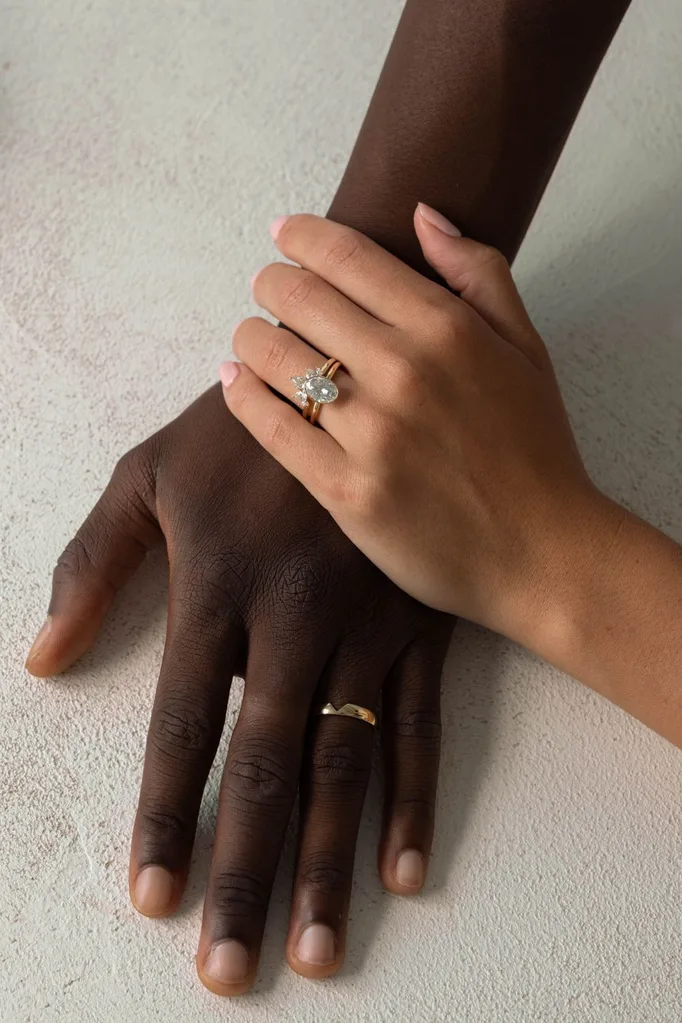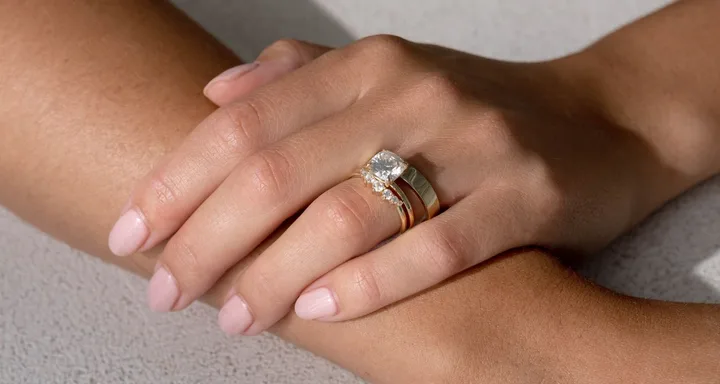There’s a reason we labour over engagement rings. The shiny piece of jewellery holds pride of place on the fingers of many, filled with meaning and sentiment, and designed to be loved for a lifetime.
So, it makes sense that, for the last 400 or so years, white diamonds have been the default choice for proposals, thanks to their durability, clarity, and overall sparkle.
But as technologies advance, and consumers become more conscious of issues surrounding the ethics and sustainability of mined diamonds, an array of diamond alternatives have entered the engagement ring arena.
In order to decipher these options and choose the right gemstone for you, we’ve enlisted the expert advice of Makayla Donovan, the founder of The Moissanite Company, and Lauren Sommer, Managing Director of Moi Moi.
Whether you’re planning on popping the question, or hoping that a proposal might be on your horizon, here’s everything to know about moissanite, lab diamonds, and mined diamonds.

What Is Moissanite?
“A moissanite is its own unique gemstone, just as sapphires and emeralds are their own unique gemstones,” Makayla explains.
Like other gemstones, moissanite is naturally occurring, however it doesn’t occur in nature in large enough quantities to be used jewellery. So, the moissanite used in engagement rings is typically lab grown.
And while they are technically different, she adds, “Moissanite boasts a similar durability to a diamond, as well as an uncanny visual resemblance to a diamond, making it the perfect alternative for bridal jewellery,” she adds.
What Is The Difference Between A Lab Grown Diamond And A Mined Diamond?
“Optically and chemically – there is no difference,” says Makayla.
Where they do differ, however, is the conditions under which they were produced. “A lab diamond is grown in a laboratory under controlled conditions, and a ‘traditional’ diamond is mined from the earth,” she says.

What Is The Price Difference Between A Mined Diamond, A Lab Grown Diamond, And A Moissanite?
Where the three gemstones differ most is price.
Makayla explains that a 1 carat moissanite retails for around $2,000, while a 1 carat lab grown diamond retails for around $4,500, and a 1 carat mined diamond for approximately $12,000.
It’s important to note, however, particularly in the case of diamonds, that pricing will fluctuate depending on the cut, colour, and clarity of the stone.
Moissanite’s lower price is thanks to the controlled conditions they are grown in, Makayla explains: they’re synthesised and grown in a unique way that allows for all gemstones produced to be the same high colour and clarity grade.
“On the contrary,” she says, “lab grown diamonds are grown with much more variance, so a higher quality costs more than a lower quality lab grown diamond, just like their mined counterparts.
Is Moissanite As Durable As Diamond?
The strength of a mineral—i.e., how easily it will scratch or corrode—is measured according to Mohs scale of hardness, a universal system of measurement devised in 1812 by the German mineralogist, Friedrich Mohs.
“Moissanite is the second hardest gemstone, sitting at a 9.25 on the scale, while a diamond is the hardest gemstone at a 10,” says Makayla.
“This places moissanite as an incredible durable option for your forever ring.”
Why Are People Increasingly Steering Away From Mined Diamonds?
Beyond price, Lauren says more customers are turning to lab grown diamonds (and moissanite) for their ethical and sustainable promises.
“Lab grown diamonds usually offer a guaranteed source of origin, so there is transparency around where you diamond came from, and no risk of a murky history.”
Similarly, many lab grown diamond producers—like the one used at Moi Moi–”are either solar powered or have a renewable energy certification, so there is significantly less impact on the environment compared to traditional mining.”










